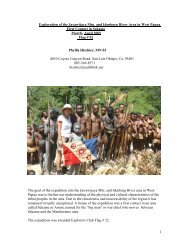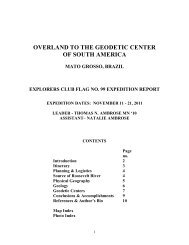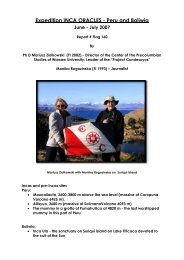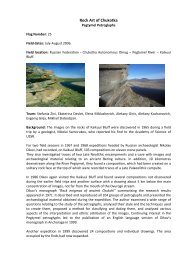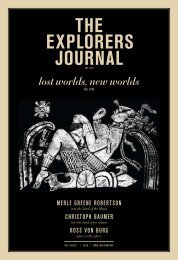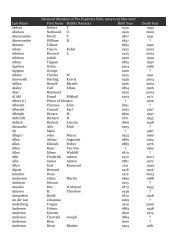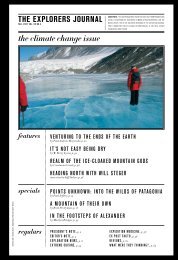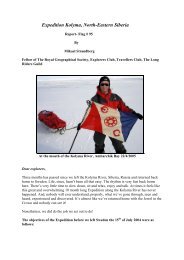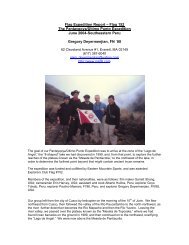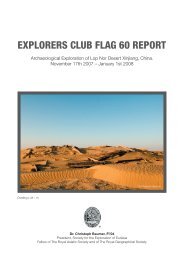the explorers journal - The Explorers Club
the explorers journal - The Explorers Club
the explorers journal - The Explorers Club
You also want an ePaper? Increase the reach of your titles
YUMPU automatically turns print PDFs into web optimized ePapers that Google loves.
Earth environments, <strong>the</strong> longer <strong>the</strong> duration of<br />
stay, <strong>the</strong> higher <strong>the</strong> risk of an underlying medical<br />
disorder causing untoward consequences.<br />
MJM: Isolation and stress could certainly create<br />
psychological problems, especially in someone<br />
with an underlying predisposition or susceptibility.<br />
How do you screen for psychological stability<br />
for long-duration space flight<br />
RW: NASA employs a team of psychiatrists<br />
and psychologists to provide behavioral health<br />
screening, through interview and testing, prior<br />
to selection as an astronaut. NASA behavioral<br />
health personnel support astronauts, and <strong>the</strong><br />
flight surgeons taking care of <strong>the</strong>m, throughout<br />
<strong>the</strong>ir careers. This behavioral health support intensifies<br />
before, during, and after missions—especially<br />
long-duration missions—with scheduled<br />
opportunities for crew members to interact with<br />
behavioral health specialists.<br />
MJM: Ionizing radiation is more intense in outer<br />
space. How much of a problem will this be and<br />
what measures are being entertained to protect<br />
travelers<br />
RW: Space radiation is different from most terrestrial<br />
sources of ionizing radiation. Space<br />
radiation consists of particles (protons, electrons,<br />
neutrons, and <strong>the</strong> nuclei of elements)<br />
traveling at light- and near-light-speed. <strong>The</strong>se<br />
particles cause damage at <strong>the</strong> cellular level as<br />
<strong>the</strong>y pass through tissues. <strong>The</strong> biological effects<br />
of this unique radiation are not well known,<br />
and research is being pursued to delineate <strong>the</strong><br />
short- and long-term risks better. Spacecraft<br />
<strong>the</strong>mselves afford some protection from space<br />
radiation, and spacecraft like <strong>the</strong> International<br />
Space Station (ISS) contain areas where <strong>the</strong><br />
crew members can take shelter in <strong>the</strong> event of<br />
a space radiation event (such as a solar particle<br />
event). Research for effective shielding materials<br />
and techniques is a priority.<br />
MJM: What are <strong>the</strong> long-term effects of microgravity<br />
and how will those be addressed or<br />
minimized<br />
RW: <strong>The</strong> known long-term effects of microgravity<br />
relate mainly to loss of bone-mineral density, cardiovascular<br />
deconditioning, and loss of muscle<br />
strength. <strong>The</strong>se are minimized by aggressive<br />
aerobic and resistive exercise regimens on<br />
orbit, and aggressive rehabilitation upon return.<br />
Evidence concerning long-duration space flight<br />
is still in its early stages, though, and o<strong>the</strong>r conditions<br />
and microgravity related health liabilities<br />
might surface.<br />
MJM: How do nutritional requirements for space<br />
travel differ from terrestrial requirements<br />
RW: Nutrition remains one of <strong>the</strong> great challenges<br />
of human spaceflight. Many astronauts<br />
find that foods taste more bland in space. Some<br />
crewmembers experience weight loss. A great<br />
deal of effort is spent on providing a diet that is<br />
as interesting and varied as possible, while still<br />
fulfilling nutritional requirements.<br />
MJM: What medical issues occur with high-G<br />
forces encountered on launch and reentry<br />
RW: Space Shuttle crew members are exposed<br />
to a maximum G force three times that of gravity.<br />
Despite microgravity deconditioning, crew members<br />
tolerate reentry well. Long-duration crew<br />
members return lying recumbent to minimize <strong>the</strong><br />
untoward effects of G forces. <strong>The</strong> longer <strong>the</strong><br />
duration in space, <strong>the</strong> more difficult G forces are<br />
to tolerate.<br />
MJM: What technologies will be utilized to monitor<br />
astronaut health<br />
RW: On <strong>the</strong> ISS, we can remotely monitor vital<br />
signs and ECG, perform video telemedicine<br />
activities, perform ultrasonography, and accomplish<br />
limited laboratory work. We are developing<br />
advanced ultrasonic, colorimetric, chromatographic,<br />
video, and o<strong>the</strong>r technologies to monitor<br />
astronaut health in real time.<br />
MJM: If an adverse medical event occurs, will<br />
<strong>the</strong>re be instant communication back to earth<br />
to inform and receive instruction on medical<br />
management<br />
RW: Communication delays in low Earth orbit<br />
(LEO) are minimal, though periodic short communications<br />
blackouts can occur. Real time<br />
telemedicine is our primary medical practice<br />
and routinely performed. With exploration<br />
beyond LEO, communications delays ranging<br />
from seconds to 20 minutes will challenge us.<br />
Development of near-autonomous health care<br />
systems to support long-duration flight beyond<br />
LEO is a major goal.<br />
<strong>the</strong> <strong>explorers</strong> <strong>journal</strong>



